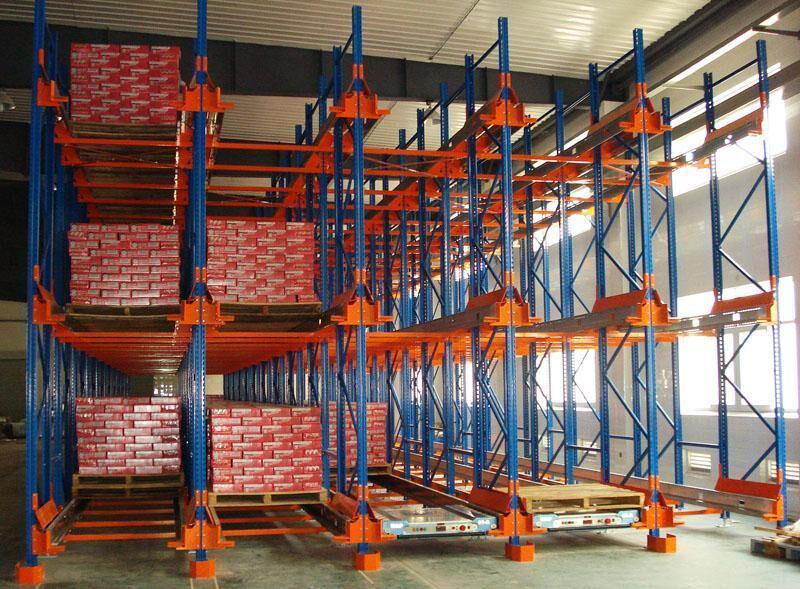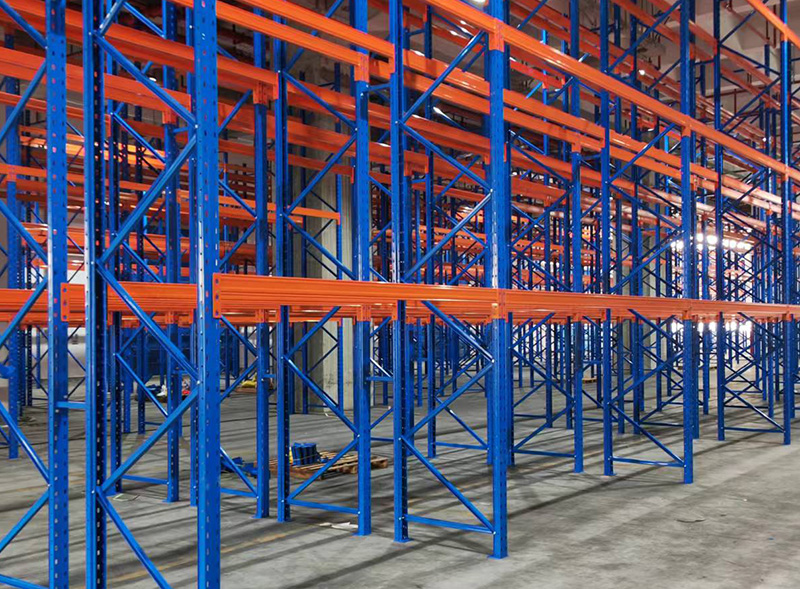In the relentless pursuit of maximizing warehouse space and optimizing operational efficiency, drive thru pallet racking stands out as a powerful solution. This high-density storage system is specifically engineered for scenarios demanding First-In, First-Out (FIFO) inventory management, allowing forklifts to literally drive through the rack structure to access pallets. Facing escalating real estate costs and the need to store vast quantities of similar SKUs, many warehouses are turning to drive thru pallet racking as a strategic asset. This comprehensive guide delves deep into the mechanics, benefits, applications, and critical considerations of implementing this space-saving storage method.

1. How Drive Thru Pallet Racking Works: The Core Mechanics
The fundamental principle of drive thru pallet racking is its accessibility from both ends of the storage lane. Unlike selective racking where aisles flank each rack, drive thru racking eliminates the need for dedicated access aisles within the storage block itself.
Structure: The system resembles a tunnel or channel formed by upright frames connected by horizontal load beams at multiple levels. These frames create parallel storage lanes running deep into the rack structure.
Forklift Access: Forklift operators enter one end of the designated lane, travel down its length, and deposit or retrieve pallets from either side of the lane. After completing the task, they exit out the opposite end of the same lane. This bi-directional access is the defining characteristic.
FIFO Enforcement: Because lanes are only accessible from both ends, pallets are naturally loaded from one end (e.g., the "loading" end) and unloaded from the opposite end (the "unloading" end). This sequential flow inherently enforces the FIFO inventory principle. Pallets loaded first are positioned closest to the unloading end and are therefore retrieved first.
Lane Depth: Lanes can be extremely deep, often holding 5, 10, 15 pallets deep or even more, depending on the specific layout, building dimensions, and product characteristics. This deep storage capability is where significant space savings are realized.
2. Key Components and Design Specifications
A robust drive thru pallet racking system relies on carefully engineered components designed to withstand the dynamic forces of forklift traffic and heavy pallet loads deep within the structure.
Upright Frames: These vertical columns form the backbone. They are typically heavier gauge steel than selective racking due to the need to support loads from pallets stored deep within the lane and withstand potential forklift impacts. They feature punched patterns for beam connection.
Horizontal Load Beams: These connect the upright frames across the width of the lane, creating the support levels for pallets. They are secured using bolts or mechanical locks into the uprights. Beam height and capacity are critical design factors.
Guide Rails / Lane Guides: Installed at the base of the lane on both sides, these are crucial safety and stability components. They:
Physically guide the forklift wheels, preventing lateral deviation and potential collisions with uprights.
Support the front bottom pallet in each stack, preventing it from tipping into the lane.
Help absorb impact energy from forklifts.
Pallet Supports / Wire Decking (Optional but Recommended): While pallets can rest directly on beams, wire mesh decking is highly recommended. It enhances safety by preventing pallets or products from falling through, provides a more stable base, and helps distribute the load more evenly across the beams.
End Frames and Bracing: The frames at the very ends of each lane and throughout the structure incorporate robust diagonal and horizontal bracing. This bracing is vital for overall structural stability, especially in resisting lateral forces generated deep within the lanes or during seismic events.
Column Protectors / Guards: Heavy-duty guards bolted to the base of uprights, especially at lane entrances/exits, are essential to minimize damage from inevitable minor forklift impacts.
3. Ideal Applications and Industries for Drive Thru Racking
Drive thru pallet racking excels in specific operational environments. Its strengths are best leveraged when these conditions are met:
High Volume of Similar SKUs: It's perfect for storing large quantities of a limited number of SKUs. Think beverages (soft drinks, beer, water), packaged food, chemicals, building materials (like bags of cement or insulation), tires, or paper products.
Mandatory FIFO Inventory Management: Industries where product rotation is critical due to expiry dates, shelf life, or lot control. This includes food and beverage, pharmaceuticals (raw materials or specific finished goods), chemicals, and some manufacturing components.
Large, Bulky Items: Products that are stable, uniformly sized, and can be safely stacked multiple pallets deep benefit greatly from the deep-lane storage.
Space-Constrained Warehouses: Where the cost per square foot of storage space is high, drive thru racking dramatically increases storage density by eliminating numerous aisles found in selective systems.
Cold Storage Facilities: The high density translates directly to reduced refrigerated or frozen space requirements, leading to significant energy savings. FIFO is also often crucial in these environments. Drive thru pallet racking is a common sight in large freezer warehouses.
Bulk Storage Areas: For raw materials or finished goods held in large quantities before distribution or further processing.

4. Advantages of Implementing Drive Thru Pallet Racking
Choosing drive thru pallet racking offers compelling benefits for qualifying operations:
Maximum Storage Density: This is the primary advantage. By storing pallets deep within lanes and eliminating internal access aisles, drive thru pallet racking can achieve up to 75% more pallet positions per square foot compared to selective racking. This directly reduces the required warehouse footprint or allows for significantly more inventory within an existing space.
Efficient FIFO Inventory Control: The system inherently enforces First-In, First-Out flow, crucial for perishable goods, products with expiration dates, or items requiring strict lot traceability. This reduces waste and ensures product quality.
Reduced Aisle Space: The consolidation of storage into deep lanes with only main cross-aisles needed minimizes non-productive floor space dedicated to forklift travel paths.
Good Accessibility (for FIFO): While not as instantly accessible as selective racking for any SKU, drive thru pallet racking provides excellent access within the FIFO flow. Forklifts can quickly enter a lane dedicated to a specific SKU and access the required pallet position.
Structural Strength and Durability: Designed for demanding use, quality drive thru pallet racking systems are built to handle heavy loads and the rigors of frequent forklift entry and exit.
Potential for High Throughput: For operations dealing with large volumes of a few SKUs, the dedicated lanes can enable efficient loading and unloading cycles, especially when inbound and outbound docks are positioned logically relative to the rack ends.
5. Critical Considerations and Potential Drawbacks
While powerful, drive thru pallet racking is not a universal solution. Careful evaluation of its limitations is essential:
Reduced Selectivity / SKU Flexibility: This is the major trade-off for density. Each lane is typically dedicated to a single SKU (or very few compatible SKUs). Accessing a pallet deep within a lane requires retrieving all pallets in front of it. It's poorly suited for warehouses needing instant access to a vast number of different SKUs.
Lower Space Utilization per Lane (vs. Drive-In): Compared to its cousin, drive-in racking (LIFO), drive thru pallet racking requires slightly more space per lane due to the need for structural support and clearance at both ends for forklift access. Drive-in only needs access at one end.
Forklift Operator Skill and Training: Operating within the confined lanes of drive thru pallet racking demands skilled operators. Maneuvering deep into lanes, handling pallets accurately, and navigating safely requires specific training and experience. Less experienced operators increase the risk of accidents and rack damage.
Higher Initial Investment: The structural components (heavier uprights, guide rails, bracing) and often the need for wire decking make the initial cost per pallet position higher than selective racking. However, the space savings often justify this cost over time.
Increased Risk of Damage: The close proximity of racking and frequent forklift traffic within lanes inherently increases the potential for impacts to uprights, beams, and guide rails. Robust column protectors and strict operational protocols are mandatory.
Lighting and Ventilation Challenges: Deep lanes can create dark areas in the center of the rack block and potentially hinder air circulation, which can be a particular concern in cold storage. Specialized lighting solutions may be needed.
Careful Warehouse Layout Planning: Optimizing the layout for efficient product flow (inbound loading end vs. outbound unloading end) and ensuring adequate main aisle widths for forklift traffic is crucial for maximizing the benefits of a drive thru pallet racking system.
6. Operational Best Practices for Drive Thru Systems
To ensure safety, efficiency, and longevity of your drive thru pallet racking investment, adhere to these practices:
Comprehensive Operator Training: Mandatory, ongoing training focused on safe maneuvering within lanes, proper load handling at depth, speed control, and awareness of the rack structure. Simulators or supervised practice lanes can be invaluable.
Strict Lane Discipline: Enforce clear lane assignments for specific SKUs. Implement visual management (signage, floor markings) to prevent incorrect pallet placement.
Robust Damage Inspection Program: Implement daily visual inspections by operators and regular formal inspections by qualified personnel. Have clear protocols for reporting and repairing any damage immediately. Never allow damaged components to remain in use.
Adherence to Load Capacities: Never exceed the designated load capacities for beams, uprights, or decking. Ensure pallet weights are accurately known and communicated. Consider dynamic load factors.
Proper Pallet Quality: Use only strong, undamaged pallets that meet dimensional specifications. Weak or broken pallets can collapse within the deep lane, causing significant disruption and safety hazards.
Maintain Clear Aisles: Keep main cross-aisles completely clear of obstructions to ensure safe forklift movement and access to lane entrances/exits.
Optimized Putaway and Picking: Coordinate putaway to the designated loading end of lanes and picking from the unloading end to maintain the FIFO flow efficiently.
7. Drive Thru vs. Drive-In Racking: Choosing the Right FIFO or LIFO
Drive thru pallet racking is often compared to drive-in racking. Understanding the key difference is vital:
Drive-In Racking:
Access: Forklifts enter and exit the lane from the same end.
Inventory Flow: Enforces Last-In, First-Out (LIFO). The last pallet loaded is the first one accessible.
Density: Slightly higher density than drive-thru per lane because it only requires structural support and clearance at one end.
Applications: Best for high-density storage of non-perishable goods where LIFO is acceptable (e.g., seasonal items, archived materials, certain raw materials).
Drive Thru Pallet Racking:
Access: Forklifts enter one end and exit the opposite end.
Inventory Flow: Enforces First-In, First-Out (FIFO).
Density: Slightly less dense per lane than drive-in due to the need for access/structures at both ends, but still vastly superior to selective.
Applications: Essential for FIFO requirements (perishables, expiry dates, lot control).
Drive thru pallet racking is an exceptionally effective high-density storage solution when the operational requirements align. Its unparalleled ability to maximize pallet positions per square foot while enforcing strict FIFO inventory control makes it indispensable for industries dealing with large volumes of perishable goods, time-sensitive materials, or homogeneous products in bulk.
However, its success hinges on careful planning and execution. Warehouse managers must honestly assess their SKU profile, inventory turnover rates, required selectivity, and operator capabilities. The trade-offs in flexibility and the demands on operator skill and warehouse discipline are significant factors.
If your operation stores large quantities of a limited number of SKUs and mandates FIFO rotation, drive thru pallet racking warrants serious consideration. Consult with experienced racking manufacturers and warehouse design engineers. They can conduct a detailed analysis of your inventory, flow patterns, building constraints, and equipment to determine if drive thru pallet racking is the optimal solution to unlock significant space savings and operational efficiency within your supply chain. Implementing it correctly transforms your storage capacity and streamlines your FIFO processes.







